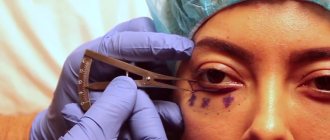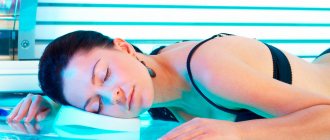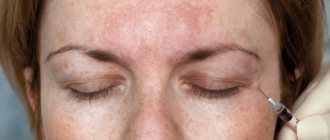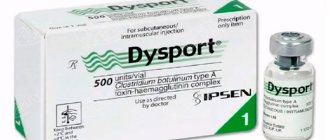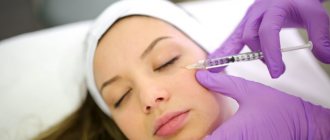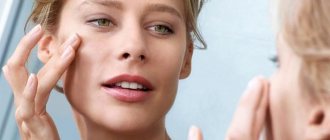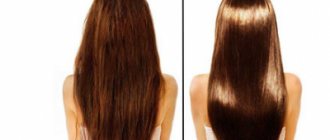Botox: what is it, features
Botox is an injectable solution based on botulinum toxin, the strongest neurotoxin in nature. In cosmetology and medicine, it is used in diluted form, which does not pose a threat to humans. The principle of Botox is to block the signal from the brain to the muscles. As a result, they stop working.
In medicine, it is used to treat cerebral palsy, epilepsy, chronic migraine, strabismus, muscle spasms and other neurological diseases.
In the 1970s, scientists, noticing the muscle-paralyzing effect, began conducting tests on patients with strabismus. During the experiments, they discovered another interesting effect - the disappearance of facial wrinkles at the injection sites. It turned out that botulinum toxin injections do not harm health, so they began to use it in cosmetology. This is how botulinum therapy appeared.
Botulinum toxin-based substances have different commercial names that are identical to the names of the drugs:
- Botox;
- Botulax;
- Dysport;
- Relatox;
- Xeomin.
Injections are made into areas of the body (directly into the muscles) where the most wrinkles form. All this is done with local anesthesia and does not take much time. After a maximum of 10 days, the drug begins to take full effect. At this time, a person’s facial expressions may be impaired due to paralysis of muscle fibers.
The effect lasts from 3 to 8 months, but on average six months. A lot depends on individual characteristics. After this period, the ability to express one’s emotions through facial expressions gradually returns. But often a habit of doing without it develops.
Who can use Botox and who can't?
Indications for botulinum therapy:
- facial wrinkles on the forehead, bridge of the nose;
- nasolabial folds (it is advisable to use fillers in addition);
- the need to correct the oval of the face;
- photoaging;
- age-related changes;
- hyperhidrosis (increased sweating);
- the need to change the shape of the nose (Botox can visually narrow the nose).
Contraindications to the procedure:
- antimicrobial therapy;
- oncology;
- pregnancy or lactation period;
- poor eyesight;
- asthenia (muscle weakness);
- menstruation;
- poor blood clotting;
- herpes in acute form;
- calcium intake.
Before the procedure, it is necessary to inform the doctor about all your diseases so that he takes this into account. If there is a tendency to bags under the eyes or swelling of the face, you should also tell your doctor about this.
Video: What is Botox and what wrinkles does it eliminate?
Botulinum toxins: composition, application features
Botox, the collective name for muscle relaxants, is considered the most popular product used in injection cosmetology. The substance is produced by isolating the botulism virus type A from bacteria.
The fraction is a protein substance that undergoes purification, stabilization, and drying. Albumin or gelatin sodium chloride is added to the resulting hemagglutinin.
Ready-made botulinum toxin is sold in the form of a lyophilisate (dry powder). To use the substance requires dissolution with sodium chloride in a certain proportion.
Botox is used to relax muscles. When the drug is administered, a local blocking of nerve impulses occurs, which makes it possible to immobilize a specific muscle. This allows you to provide motor rest to a separate area. In cosmetology, this property is used to temporarily eliminate wrinkles. Botox disrupts facial activity, which is recognized as the main cause of skin wrinkles.
Botox reliably eliminates wrinkles for 3-12 months. Modern drugs allow you to achieve a natural result that does not turn your face into a mask. The duration of retention of the effect depends on the dosage of the substance used, lifestyle, and characteristics of the body. Motor activity returns to the muscles gradually.
Note! The formation of new wrinkles occurs as facial expressions increase. In some cases (by controlling facial movements), the formation of wrinkles in certain places can be delayed or avoided.
Choosing Botox as a means of injection correction is recommended for those who have bright facial expressions. At the same time, complex age-related changes are invisible, and wrinkles are actively forming, disrupting aesthetic appeal.
Advantages and disadvantages of Botox
Among the advantages of botulinum therapy are the following:
- fast completion of the procedure;
- painlessness;
- quick effect;
- the frequency of repetition of the procedure is no more than once every 3 months;
- prevention of deep wrinkles;
- lack of rehabilitation period.
If the procedure is carried out in compliance with all necessary antiseptic and sanitary requirements, and a qualified cosmetologist administers Botox, then serious complications and negative consequences can be avoided. Otherwise, you may encounter the following negative consequences:
- distortion of facial expressions;
- pronounced swelling of the face;
- paralysis of the muscles around the mouth;
- shorter-term effect in athletes;
- drooping of the eyebrows, eyelids and corners of the lips;
- mask effect on the face;
- inability to blink normally, chew food and swallow.
To avoid most undesirable consequences, you need to choose a doctor with a higher specialized education and extensive experience working with Botox.
Secrets of choice
The right choice - Botox or filler - can only be made by a cosmetologist after a face-to-face consultation with the patient. The doctor takes into account the current condition and individual characteristics. Cosmetologists often recommend the use of one or another technique depending on the location of the problem. Most doctors are confident that it is better to remove eyebrow wrinkles with Botox, and correct nasolabial lines with filler. But crow's feet can be easily eliminated by any of the methods.
Cosmetologists often focus on the condition of the skin. For owners of dry, flabby skin, they prefer to recommend the use of filler or preliminary mesotherapy and biorevitalization. It is difficult to bring an aged face into an aesthetic appearance without an integrated approach. In this case, doctors combine Botox and filler, using the drugs in different areas, performing procedures at intervals of time.
Attention! Cosmetologists are not inclined to advise young patients to start with injection techniques. Peels, massages, well-organized regular care can delay the onset of age.
Filler: what is it, features
Fillers are drugs that are used to fill voids or wrinkles. They are used to obtain a lifting effect and correct facial contours. The procedure is called filling and is used for:
- smoothing nasolabial folds, filling lips and filling deep wrinkles;
- correction of cheeks and cheekbones;
- correction of facial asymmetry;
- adjustments to the shape of the ears;
- correction of the buttocks, arms or décolleté.
The filler is usually hyaluronic acid (a natural component of the intercellular matrix), collagen, and the patient’s own adipose tissue. The filler has a dense gel consistency.
During the procedure, the doctor applies a creamy local anesthetic to the area of skin being treated. Simultaneously with the slow introduction of the filler, the cosmetologist distributes it with light pressure on the skin. The effect becomes noticeable immediately - the wrinkle disappears. The doctor imitates the patient's facial expressions with his hands to check how the muscle and skin behave. If new wrinkles form at the same time, the doctor injects the drug there as a preventive measure.
After the procedure, redness and swelling may appear at the injection sites. This is the body's natural reaction to stress and skin damage. In a few days everything will pass.
Over time, the gel dissolves in the dermis and the effect disappears.
Fillers that are in greatest demand:
- Restilain Perline;
- Lal system;
- Belotero;
- Princess Volume;
- Teosyal;
- Juviderm.
The effect of fillers is longer lasting than the effect of Botox - from 6 months to a year.
The duration of action of fillers depends on:
- patient's age;
- lifestyle;
- exposure to sunlight;
- use of a bathhouse, sauna;
- use of certain medications;
- diet.
The procedure has the following contraindications:
- hypersensitivity to any of the components, including allergic reactions to anesthetics;
- pregnancy;
- lactation period;
- acute inflammatory processes in the body, including autoimmune ones.
After the procedure, the face looks renewed and rejuvenated. Wrinkles are smoothed out, the face glows with freshness.
Comparison of procedures
In order to find out which is better to use, let's compare these two methods.
Main advantages of the procedures
First, let's define all the pros and cons of both procedures.
The advantages of fillers (fillers) include the following indicators:
- injected hyaluronic acid not only replenishes wrinkles, but also rejuvenates the skin as a whole;
- the result can be observed after the first procedures;
- fillers have no contraindications for age;
- able to smooth out deep wrinkles.
The advantages of Dysport are that its use:
- does not distort natural facial expressions;
- smoothes not only age wrinkles, but also facial wrinkles;
- skin looks fresher.
Main differences between procedures
Upon closer examination, you can understand that these two methods of eliminating wrinkles differ from each other:
- Mechanism of action:
- Dysport relaxes muscles
- fillers fill voids in the skin.
- Method of drug administration:
- administered intramuscularly,
- injections of hyaluronic acid subcutaneously, as well as using a device (as opposed to Dysport).
- Security:
sessions with fillers are safer and cause fewer complications.
- Spectrum of action:
fillers have a rejuvenating effect.
However, there are cases when cosmetologists recommend using both procedures simultaneously. This is done to achieve better results in eliminating deep wrinkles and creases. Filler can be used after Dysport only after it has had its final effect on the muscles.
Beauty and health to you!
Botox and fillers are widely advertised drugs for correcting imperfections in appearance. What should you choose? Which is better – fillers or Botox for lip augmentation? In order not to get confused about what you personally need, you need to clearly define what one and the other means are and for what purposes each drug is used.
Fillers are filler preparations designed specifically to eliminate wrinkles and skin folds by replenishing the volume of skin tissue. Contains collagen, polylactic and hyaluronic acids.
Botox (botulinum toxin) is a specially purified protein used to forcefully relax muscle tissue, the tension of which led (leads) to the appearance of wrinkles. They do not pump or fill anything; it only forcibly relaxes the muscle responsible for the appearance of hated folds on the face.
Advantages and disadvantages of filler
Advantages of fillers:
- do not cause pigmentation, so the procedure can be performed at any time of the year;
- stimulate the skin's production of its own collagen and activate metabolic processes in the dermis, improving skin quality;
- Repeated injection of fillers can correct the errors of the previous procedure.
Disadvantages and possible side effects of fillers:
- tissue necrosis;
- granuloma;
- painful procedure;
- swelling and redness due to a vessel clogged with gel;
- the appearance of edema due to anesthesia;
- rehabilitation period up to 14 days;
- unnaturalness of the face or its parts when administering excessive doses of the drug;
- possible rejection by the body of the filler as a foreign body;
- allergic reactions;
- the development of tissue fibrosis and the formation of scars when moving synthetic filler (although these have not been used widely for a long time);
- development of benign neoplasms;
Even a certified specialist cannot guarantee the absence of side effects. Therefore, you need to take the procedure seriously, carefully considering your decision.
Complications and ways to eliminate them
Sometimes after the procedure you may not get the effect you expected. There is a possibility of complications. In cosmetology they are usually divided into short-term and long-term.
Short-term complications of facial fillers:
- The puncture sites react painfully to touch.
- The skin turns red and itches.
- Bruises.
- The puncture sites become inflamed due to bacteria.
- Asymmetry appears.
Within 10 days they go away on their own. If not, they can be easily corrected by a specialist.
For example, bruising is almost impossible to avoid. You can reduce them and affect the speed of healing. To do this, before the procedure you must follow the rules described above.
Asymmetry can only be corrected by a cosmetologist. Having studied the situation, he will either add fillers to this area or neutralize the previously injected substance.
If after 10 days there is no result, you need to repeat the procedure, possibly using a different brand of drug.
Long-term complications of facial fillers:
- Accumulation of the drug in one area and turning it white.
- Allergy.
- Formation of nodules.
- Tissue ptosis due to incorrectly calculated amount of filler.
- Development of vascular embolism (if the doctor hits a vessel with a needle).
- Movement of the drug under the skin.
If at least one of these complications develops, you should immediately contact your doctor.
What is the difference between Botox and filler
Filler and Botox have different purposes. The first fills wrinkles and voids, adds volume, and the second paralyzes groups of facial muscles.
Botox does not produce a visible effect immediately, unlike fillers, the effect of which can be seen instantly.
Filling the necessary areas with fillers is a painful procedure. Botox, on the other hand, does not cause any pain.
The main differences between fillers and Botox:
- different principles of operation;
- Botox does not change the skin, but fillers do, giving it volume and improving its properties;
- the composition of the injections is radically different, as described in detail above;
- Botox is used most often in the upper part of the face, and fillers are used in any part of the face, and also on other parts of the body;
- Botox does not have a recovery period; for fillers it is about two weeks;
- Botox has more contraindications and more serious side effects that are difficult to eliminate;
- price - Botox is cheaper than fillers.
Cosmetologist's answers to questions
The specialist determines what is best for the patients who apply, Botox or injectable fillers. However, clients must be fully informed about the upcoming procedure, know its pros and cons, and why the doctor chose a certain type of injection.
We offer you answers from a cosmetologist to the most common questions.
What to choose?
I often hear women ask what is the difference between subcutaneous filler and intramuscular Botox. I always say that each product has its own advantages and disadvantages. My task is to determine which type of drug is suitable for a specific skin type. It also matters what goals we strive to achieve. For example, Botox is better to combat crow's feet. If you need to refresh your skin and rejuvenate it, I recommend injectable fillers.
Is it possible to combine Botox and filler procedures?
Cosmetic clinics practice the simultaneous use of botox and fillers. We are talking about injections of various agents into different parts of the face, where they will be most effective.
If you need to get both Botox and injectable fillers in the same area, do the botulinum toxin procedure first. Then, after 2 weeks, a similar manipulation is performed, but using a combination with fillers. In this way, cosmetologists maximize the effect of anti-aging manipulations.
What is better for rejuvenation?
Both types of drugs are used for rejuvenation. Botox is more often used for the upper part of the face. It does an excellent job of removing frown lines between the eyebrows, eliminating crow's feet and horizontal lines on the forehead.
With the help of fillers, cosmetologists lift the corners of the lips, making the lips more pronounced and slightly swollen. Subcutaneous preparations help correct cheekbones, earlobes, and cheeks. Fillers can change the contour of the face and eliminate small scars.
What is better for correcting facial features?
When it is necessary to correct facial features, cosmetologists opt for fillers. This preference is made due to the ability of fillers to fill the subcutaneous space. This is how we place accents on our appearance, making it brighter.
Injectable fillers last for a year. With their help, we compensate for the lack of nutrients necessary for the normal functioning of the skin.
